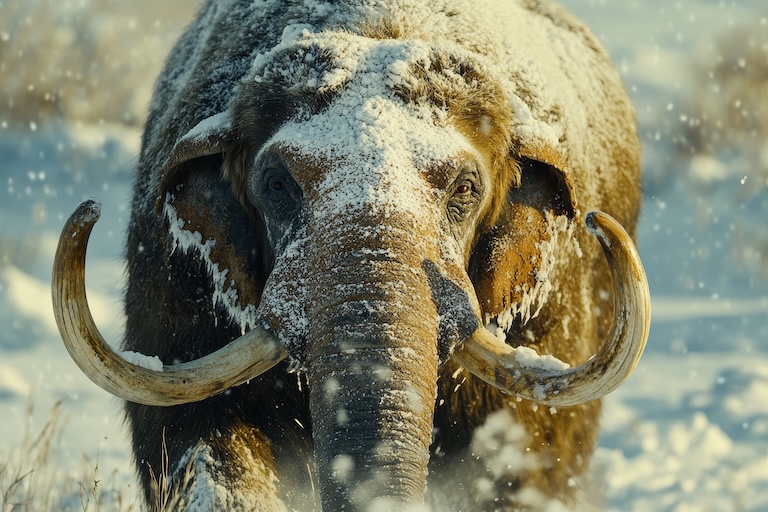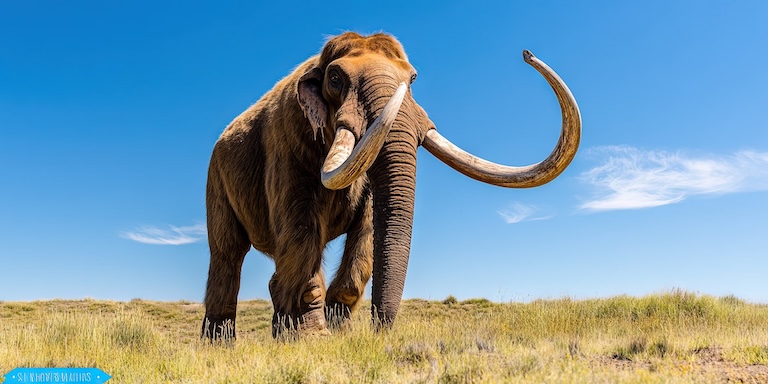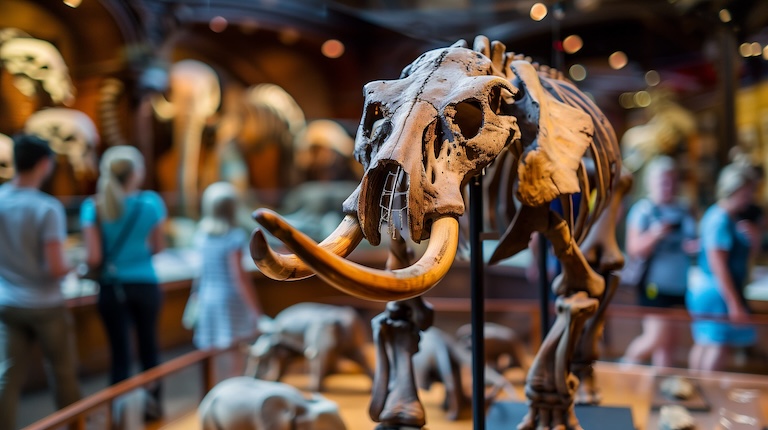Mastodon Profile
Before the increasingly popular social media platform, before the heavy metal band from Atlanta, even before mammoths roamed the prehistoric plains, there was a dumpy sort of tusked and long-nosed herbivore known as the paleomastodon.
This hippo-sized proboscidean had a face like a 1980s TV show puppet, but would eventually give rise to a huge diversity of enormous elephants, including the subject of today’s piece: the mastodon.

Mastodon Facts Overview
| Habitat: | Forest |
| Location: | North and Central America |
| Lifespan: | Unknown |
| Size: | Up to 3m (10ft) tall |
| Weight: | Up to around 6 tons |
| Colour: | Unknown |
| Diet: | Likely woody material, bark, leaves and grass |
| Predators: | Humans, lions, bears, wolves |
| Top Speed: | Unknown |
| No. of Species: | More than 10 identified |
| Conservation Status: | Extinct |
Until the Woolly mammoth took over the spotlight for prehistoric proboscideans, there was the OG Tusker that started it all. Mastodons differ from mammoths in several ways, including the shape of their skulls and tusks, and in particular their teeth.
These teeth imply a vastly different diet, and therefore habitat, from the mammoth, and apparently served the genus well over the course of their almost 30-million-year reign.
But like 70% of large mammals, they couldn’t survive the Holocene, and with pressure from climate change and the growing population of bipedal apes, they died out around 10,000 years ago.
Interesting Mastodon Facts
1. They predate elephants by around 20 million years
Despite being distinctly elephant-like, mastodons are far more ancient animals than elephants and mammoths. Mammoths were a genus of elephant that emerges in the fossil record around five million years ago.
Mastodons, on the other hand, show up somewhere between 27 and 30 million years ago. The largest of them were roughly the size of today’s African elephants, so they were also much smaller than the [largest of mammoths]. 1
2. They took over the world
While they originated in Africa, Mastodons managed to roam the majority of the planet, occupying everywhere but Antarctica, and persisted as long as the majority of mammoths, until around 10,000 to 12,000 years ago. 2

3. They could grind bark with their Nipples
In 1796, Georges Cuvier became one of the first scientists to figure out that these enormous animals had only recently gone extinct and paved the way for Pleistocene archaeology.
The name mastodon comes from the Greek for ‘breast’ and ‘tooth’, on account of these giant elephant-like animals having what the taxonomist thought looked like a nipple on their molars.
Leave it to the French to look at a fossilised animal tooth and still think of breasts, but there’s no doubt that these molars look very different from those of mammoths and modern elephants.
Mastodons had incredible interlocking spurs on their molars, totally divergent from the horizontal ridges of an elephant’s grinding teeth, and therefore suggest a very different diet.
Researchers infer from the teeth that the mastodon was a browser, able to chew up tough materials including bark, leaves and rough grasses, and the ‘nipples’ were excellent for cracking and crunching into sticks from woody shrubs. 3
4. These teeth would last them a lifetime
Another distinctive characteristic of mastodons that separates them from elephants is how resilient their teeth were.
As nipples go, these were very hard. Both mammoths and modern elephants had six sets of teeth, increasing in size as they grew, and being replaced by a new set when they were worn down.
Mastodons were endowed with just one set of teeth that had to last them a lifetime.
5. Palaeontologists find their remains in spear points
Nowadays, it’s considered a feat to walk uphill to the refrigerated shelves of the supermarket in search of meat, but early settlers on the American continent used distinctive stone spears to acquire theirs, and modern science is getting so clever that researchers are now able to identify the tiniest of proteins, trapped inside microfractures in these stones.
What they’re discovering is the range of animals that were actively hunted by late Pleistocene humans.
From these 13,000-year-old spearheads, emerges a buffet of bison, horse, and proboscidean (trunk-faced animals) meat. While previous similar research found no sign of mammoth or mastodon proteins, recent explorations have.
This not only proves that mammoths mastodons shared North America with the Clovis peoples, but that they were commonly on the menu, and adds to the growing pile of evidence of human involvement in their eradication. 4

6. Humans hunted them in Florida over 14,000 years ago
Knife fragments have even been found in mastodon fossils from Florida, dating back 14,550 years. This knife was the key to figuring out the age of the site – one that had been long studied, yet not properly aged.
Discoveries like this continually push back the date of human migration into the Americas. The tools from this site predate the Clovis people by a thousand years, and DNA research has inspired hypotheses that the first arrivals may have come three thousand years prior even to this.
The mastodon remains suggest these people would have removed the huge tusk to get at the marrow-like pulp inside the base.
7. The debate around their extinction continues
It seems unquestionable that the rapid shift in climate after the last Ice Age contributed significantly to the decline and extinction of the majority of huge herbivores, and consequently, the frightening array of large predators that fed on them.
But this extinction event is not so cut and dried. Warming temperatures favoured human migration, and historically, this is a disaster for wildlife. It’s not a coincidence that the most biodiverse regions on Earth are those that are hardest for humans to reach.
Human hunting and the massive population booms that fuelled it formed one part of a pincer manoeuvre that reduced large animal populations from both ends of the food chain, with climate change reducing habitat and feeding grounds so that there was nowhere left to turn.
Such was the effectiveness of human destruction that they were able to wipe out a global population of Mastodons and 70% of large-bodied mammals with 0.01% of today’s population. How much either factor contributed is still a matter of ongoing debate.
Mastodon Fact-File Summary
Scientific Classification
| Kingdom: | Animalia |
| Phylum: | Chordata |
| Class: | Mammalia |
| Order: | Proboscidea |
| Family: | Mammutidae |
| Genus | Mammut |
Fact Sources & References
- (2007), “Mastodon DNA sequenced”, nature.
- “Mastodon”, San Diego National History Museum.
- Lisa Hendry, “’Monstrous’ mastodon molar”, Natural History Museum.
- (2014), “Forensic evidence suggests Paleo-Americans hunted mastodons, mammoths and other megafauna in eastern North America 13,000 years ago”, The Conversation.
